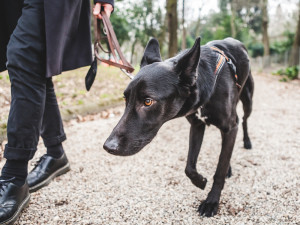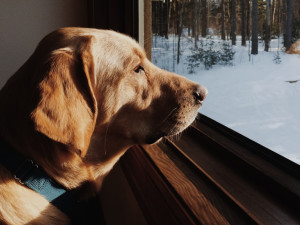Making Short Absences Easy: How To Leave Your Dog Home Alone
Scientists from the Waltham Petcare Institute explain how one simple buy could help your nervous pup feel more comfortable by themselves

Share Article
Before I adopted Lucy, I was unprepared for how much I’d think about her – all the time – constantly worrying about her emotional state: is she happy? Maybe she’s sad? Is she comfy? Does she miss me when I’m gone…?
It’s been four years since she entered my life and stole my heart, but those first months of her learning to trust me are etched into my memory. She was a rescue dog with a whole load of emotional baggage and nervous energy. For the first few weeks, I barely left her side. I didn’t want her to think I’d ever desert her.
She can now be on her own at home for hours at a time – not that I make a habit of it – but when I do, I’ll leave her with some treats and she’ll sprawl out on my (okay, it’s hers now, really) bed and go to sleep. But we built up to that. The first time I left her alone was for a mere 30 seconds. Looking back, it’s hard to know who was more anxious about the separation – me or her? When we made it to 10 minutes, I have a vivid memory of calling my mum as I sat on the steps by my front door. “I hope she’s okay in there,” I wailed, tears streaming down my cheeks. My mum reassured me she was fine. But was she? How can we ever truly know?
Lucy’s happiness is why I’m forever devouring bits of research and new discoveries that might just make her existence that bit happier. That’s what the researchers at Waltham Petcare Instituteopens in new tab have dedicated themselves to. Their goal is to help our pets live happier lives and, one of their most recent studies explores the very issue of what happens to dogs when they’re alone.
One of the study’s authors, research scientist Hannah Flint who has a PhD in epidemiology and animal welfare, agrees to chat to me over Zoom from inside the grounds of Waltham, which is home to hundreds of dogs (and cats!) who live in state-of-the-art facilitiesopens in new tab. This particular studyopens in new tab is all about the emotional state of dogs when left alone for short periods of time and what can help. It enlisted 20 dogs (12 females and 8 males) who were each left alone for 20 minutes with various forms of enrichment – a chew, for example, or a treat-dispensing toy – to see what impact that had on their emotional state. “We wanted to find anything that could help reduce boredom and make dogs happier and more comfortable when they're on their own,” explains Hannah.
Because, here’s the thing: “dogs are a social species that can develop meaningful connections with their caregivers, similar to those between children and parents,” notes the study, and 22% to 55% of dogs display negative emotional behaviours when left alone – the study also acknowledged that figure could be much higher, due to pet parents misreading or not seeing their dog’s body language (more on that later).
Is this the secret weapon?
Okay, so the study used different food-based enrichments while the dogs were alone: a long-lasting chew, kibble in a treat-dispensing toy, and kibble dispensed through treat-dispensing devices (one that was activated with a voice and one without).
What did they learn? “Some active activities, for example a Kong Wobbler, stimulate food-seeking behaviours, leading the dogs to be more active and frustrated once that was complete,” explains Hannah. This kind of activity is very stimulating so will excite your dog making it harder to bring their energy levels back down – not ideal when they are home alone.
Instead, promoting more calming, soothing behaviours is far more beneficial. That’s why the long-lasting chews came out on top. Chewing is calming for dogs. It triggers the release of endorphins – hormones that foster feelings of calmness and happiness, relieving stress, anxiety and loneliness.
Lucy has a rocking egg toy that she has to bash with her paw to make treats drop out the bottom, she’s jumps around like a lunatic when she plays with it and it always gives her the zoomies – she’s also been known to knock it underneath furniture and get frustrated when it she can’t get it out again. “That’s why you need to test out any toys on your dogs before you leave them alone with them,” says Hannah, “observing how they interact.” The key? Leave your dog with something that will calm rather than excite or frustrate them.
FYI, a lick mat has the same effect as a chew, as licking is a soothing behaviour that releases endorphins. I might slather on some natural yoghurt or peanut butter or soft cheese on Lucy’s lick mat (which has suction cups so it doesn’t move) so I know she’ll lick it for ages, which will relax her, then she’ll go to sleep.
But how do I know if my dog is happy on their own?
For some pet parents, it’s obvious that their dogs aren’t happy alone. “Dogs that are active, like chewers – who might eat your sofa – or those who vocalise resulting in complaints from the neighbours,” says Hannah. But dogs have different coping strategies. “Some might just shut down,” says Hannah, explaining that this is really hard to read as they just don’t move at all.
Of course, the dogs in the study might have thought they were on their own, but in reality, they were being constantly monitored with cameras and observed by a bunch of scientists who could jump in at any moment if something went wrong.
Is this something all pet parents should consider, should I get a camera set-up at home? “There are subtle signs of unhappiness that would be hard to spot if you didn’t have a camera,” says Hannah. For example, pacing, panting, whining, not settling or even looking out of the window. “Restless behaviours,” says Hannah, “perhaps your dog is constantly looking around, with their head up and they never go to sleep.”
The truth is, our dogs are constantly communicating with us and it’s up to us – their pet parents – to learn how to read them. The first time I left Lucy alone she was waiting by the front door for my return. I read that as cute. Turns out, it wasn’t cute at all, it was a subtle sign of stress – how did she know I was coming back? When I’m leaving the house, it’s actually better if she couldn’t care less about my departure and is stretched out on the bed with her tongue lolling out. Now, I try not to make a big fuss, but simply slip out and leave her to it. But no one knows your own dog like you do. It’s up to you to guide them through this life, and only leave them alone if and when they are ready for it…
“Some pet parents might have no idea how their dog is feeling,” says Hannah, “so just taking a few of these general recommendations can be really beneficial.” Even if you think your dog doesn’t have an issue being alone, it might just make them happier.

Alice Snape
Alice Snape is a freelance writer and editor whose work has featured in Cosmopolitan, Metro, Red, Vice, amongst other publications. Her rescue dog Lucy is the love of her life – probably because she’s an anxious weirdo like her. You’ll likely find them both curled up in bed – Alice’s favourite place to write from – or out having an adventure together in the park…
Related articles
![A dog looking up with a cute face]()
Your New Dog is Scared of You. Now What?
Five ways to warm a skittish dog to you
![Dog holding a toy and looking up at their owner]()
What Is Displacement Behaviour In Dogs?
And should you be worried?
![Dog looking out a window in the winter]()
Can Your Dog Suffer From Seasonal Depression?
Here’s why dogs may suffer from seasonal affective disorder, too
![woman playing with her dog in the park]()
Why Your Dog Should Be Your Go-To Stress Buster
You need a break sometimes, and your dog is ready (and willing) to take one with you
How to Help Your Dog Be Just a Little Less Needy
You love that your dog is your shadow, but maybe not when you’re on a Zoom call
![a nervous dog sits on a sofa]()
Bringing Home A Very Nervous Rescue Dog – A Guide For Anxious Parents
At so many points in those first hours, weeks, months, I screamed, internally: what have we done?









